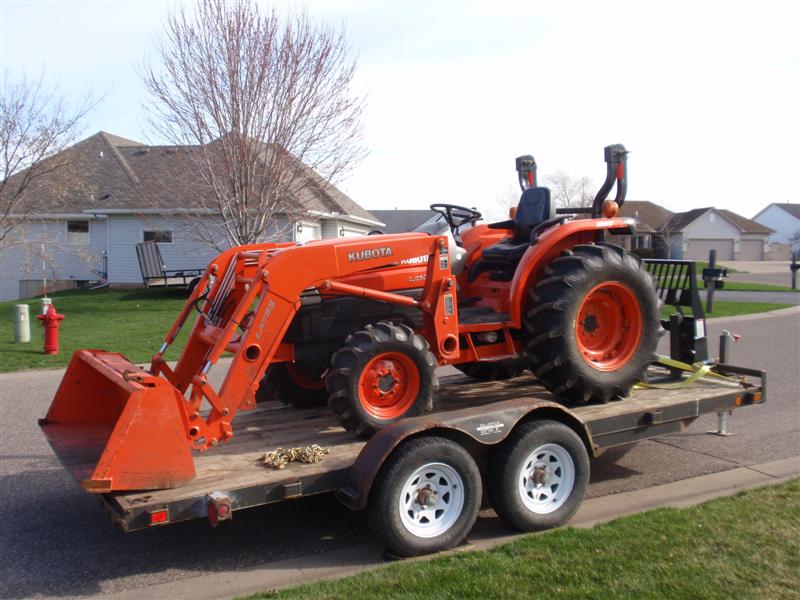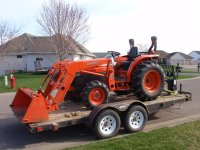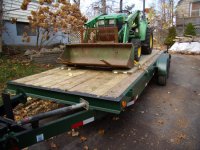dstig1
Elite Member
- Joined
- Apr 7, 2010
- Messages
- 4,787
- Location
- W Wisc
- Tractor
- Kubota L5240 HSTC, JD X738 Mower, (Kubota L3130 HST - sold)
So after reading the recent thread on hitch capacity, I decided to look into mine more closely. I have the stock OEM receiver on my 2005 F250, and the sticker says 5000 lbs/500 tongue load carrying or 10,000lbs/1000 tongue weight distributing. Right now I am running a plain old ball in the reciver, so that is weight carrying, as I understand it. The 2 5/16" ball is rated for 10k and the stinger is rated for 7500 lbs.
So the dilemma.... I start adding up weights of my trailer and tractor, and I am surely over 5k....
Tractor Kubota 3130 HST: 3005 lbs
Loader LA723: 1058 lbs
Light material bucket: 300 lbs
Farmi Skidding winch on 3pt: ~350 lbs
Rimguard in 14.9/24 rear tires: 500 lbs, ea, if I read it correctly
Add that all up and we have 5713 lbs in the tractor. Call it 5800 with fluids. Obviously this is already over 5k, and we haven't talked about the trailer.
So the trailer is a bit of a question mark. I bought it used and haven't had much luck getting a response from the builder as the nameplate/sticker is totally faded. It's in the attached pic and is 16'L x 7'w, dual axle with brakes on both axles:

Wheels are 15" tires and 6 bolt pattern. Not sure the bolt circle size right now. I'm guessing it has an 8-10k GVWR and probably weighs 2000-2200 alone. so 5800+2200 = 8k. Ayep, I'm over the hitch rating, and really didn't realize it.
So I have 2 options it seems: 1- buy a higher rated receiver, 2- add a weight distributing hitch to the trailer.
#1 is "easier" in that I would be able to just keep doing everything else "as is" and just using a normal ball.
#2 is the one I have more questions about. Since the cost is pretty close to the same either way, are the advantages to the WD hitch significant? I could keep my existing receiver and pretty much everything else. Are these things particularly difficult to connect up to the receiver? I've never dealt with one so I'm not sure how they work. If I have to line up and slide in the tongue on the trailer into the receiver, that sounds like a major exercise in frustration. So how are these things to connect up to the truck? And if I use the trailer for something substantially lighter (which I have already done) does that mess the system up and require adjustments or something?
Thanks for any help and advice you all have. This really is a great bunch of people here that are always helpful. :thumbsup:
-Dave
So the dilemma.... I start adding up weights of my trailer and tractor, and I am surely over 5k....
Tractor Kubota 3130 HST: 3005 lbs
Loader LA723: 1058 lbs
Light material bucket: 300 lbs
Farmi Skidding winch on 3pt: ~350 lbs
Rimguard in 14.9/24 rear tires: 500 lbs, ea, if I read it correctly
Add that all up and we have 5713 lbs in the tractor. Call it 5800 with fluids. Obviously this is already over 5k, and we haven't talked about the trailer.
So the trailer is a bit of a question mark. I bought it used and haven't had much luck getting a response from the builder as the nameplate/sticker is totally faded. It's in the attached pic and is 16'L x 7'w, dual axle with brakes on both axles:
Wheels are 15" tires and 6 bolt pattern. Not sure the bolt circle size right now. I'm guessing it has an 8-10k GVWR and probably weighs 2000-2200 alone. so 5800+2200 = 8k. Ayep, I'm over the hitch rating, and really didn't realize it.
So I have 2 options it seems: 1- buy a higher rated receiver, 2- add a weight distributing hitch to the trailer.
#1 is "easier" in that I would be able to just keep doing everything else "as is" and just using a normal ball.
#2 is the one I have more questions about. Since the cost is pretty close to the same either way, are the advantages to the WD hitch significant? I could keep my existing receiver and pretty much everything else. Are these things particularly difficult to connect up to the receiver? I've never dealt with one so I'm not sure how they work. If I have to line up and slide in the tongue on the trailer into the receiver, that sounds like a major exercise in frustration. So how are these things to connect up to the truck? And if I use the trailer for something substantially lighter (which I have already done) does that mess the system up and require adjustments or something?
Thanks for any help and advice you all have. This really is a great bunch of people here that are always helpful. :thumbsup:
-Dave

